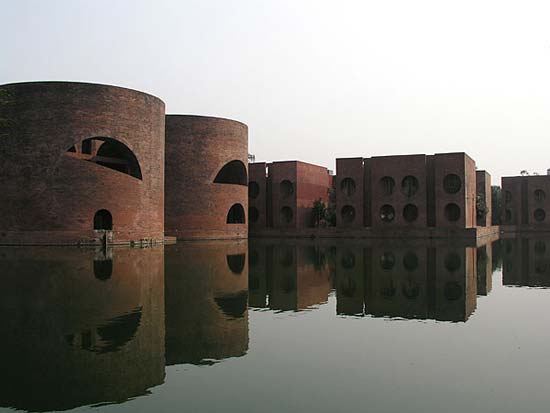Linear perfection. Monastic lines. Reductionist volumes. Unadorned surfaces. Geometric harmony. That in a nutshell was the work of Louis Isadore Kahn (born Itze-Leib Schmuilowsky), widely known as one of the most influential architects in the world. There was something starkly original and intellectually stimulating about his work. His buildings were like mathematical theorems, well-realised to the last brick but with great emotional sweep.
India knows him for his work on the Indian Institute of Management in Ahmedabad. Even though we know him today as a masterful architect with buildings whose influence has grown with time, the tragedy is that in his life, he did not get the acclaim he deserved. On March 17, 1974, he was found dead in a public lavatory at Penn Station in New York. He had died of a heart attack and was in debt. There was something monumental about his work, not necessarily in terms of scale but in detail and emotional grandeur even though life challenged him in diverse ways.
He was born in an impoverished Jewish family in Estonia. As a child, he suffered from scarlet fever and was once drawn to burning coals and suffered life long scars in a fire accident. In 1906, his family emigrated to the United States. The story goes that the family could not afford pencils for him and he made charcoal sticks, sold paintings to earn money and even played piano in silent movie theatres! He became an American citizen on May 15, 1914 and a breakthrough came when his talent won him a scholarship to study architecture at the University of Pennsylvania.
While studying architecture, he was greatly influenced by a teacher called Paul Philippe Cret who instilled in the students a belief that architecture must mirror the context and time it grows out of. He graduated in 1924, and found work, travelled Europe but during the Depression in the 30s, he was rendered jobless.This was a tough time. It was not easy being a Jew with immense talent, a reserved manner and stern idealism.
Facing financial challenges and prejudices was hard as well. After a series of modest projects, in 1951 he won his first big break that called upon him to extend the Yale Art Gallery. Despite his hardships, Kahn believed architecture was not just about function but intention, not just purpose but inspiration and emotional connection. Yes, he wanted to build modern buildings with evolved techniques but he wanted to make spaces breathe, and he wanted them to communicate with the shifting light of night and day, and to be relevant and timeless. His biggest creative triumph during that time was the Salk Institute in La Jolla, California. But his frequent conflicts with clients took away more work than he could afford to lose. His unhappy personal life did not help either.
Yet, he delivered another influential building in the late sixties and early 70s,the Kimbell Art Museum at Fort Worth in Texas. The Indian Institute of Management in Ahmedabad and the beautiful Capital Complex in Dhaka proved to be his final attempts at immortality. From 1957 till his death, he was also a professor of architecture at the School of Design at the University of Pennsylvania. His legacy in the end is that his buildings achieved a monumental stature in an age where architecture was becoming just about function. And he did it without compromising his modernity though his buildings were not just about modernism.
He was awarded the AIA Gold Medal and the RIBA Gold Medal among many other accolades. Though he was once called one of the foremost living architects, Louis Kahn suffered more than his share of pain and struggle in his life time. He was called the philosopher among architects and for good reason though he was also a great technical innovator. What he must also be remembered for are the beautiful homes he built for discerning clients who wanted modernism wedded to personal needs and vernacular traditions of building. A book called The Houses of Louis Kahn illustrates how in a way he reinvented the idea of domestic spaces in America. He was an architect who thought, felt and internalized spaces before he built them and that is why his works are not about first rate architecture but a deeply human experience.
Reema Moudgil has been writing for magazines and newspapers on art, cinema, issues, architecture and more since 1994, is a mother, an RJ , an artist. She runs Unboxed Writers from a rickety computer , edited Chicken Soup for The Indian Woman’s soul, authored Perfect Eight and earns a lot of joy through her various roles and hopes that some day working for passion will pay in more ways than just one. And that one day she will finally be able to build a dream house, travel around the world and look back and say, “It was all worth it.”








